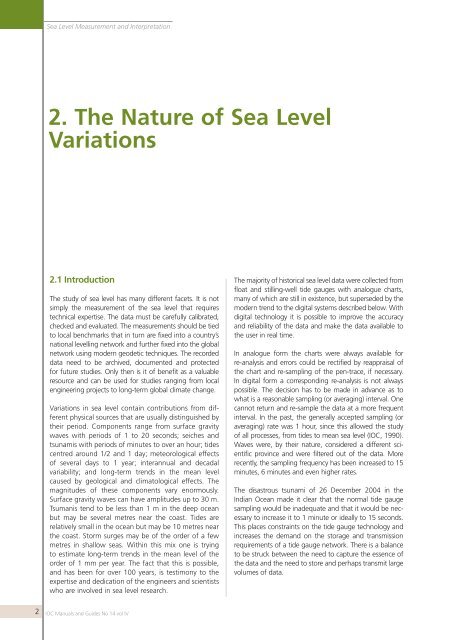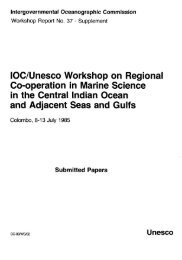Manual on sea level measurement and ... - unesdoc - Unesco
Manual on sea level measurement and ... - unesdoc - Unesco
Manual on sea level measurement and ... - unesdoc - Unesco
- No tags were found...
Create successful ePaper yourself
Turn your PDF publications into a flip-book with our unique Google optimized e-Paper software.
Sea Level Measurement <strong>and</strong> Interpretati<strong>on</strong>2. The Nature of Sea LevelVariati<strong>on</strong>s2.1 Introducti<strong>on</strong>The study of <strong>sea</strong> <strong>level</strong> has many different facets. It is notsimply the <strong>measurement</strong> of the <strong>sea</strong> <strong>level</strong> that requirestechnical expertise. The data must be carefully calibrated,checked <strong>and</strong> evaluated. The <strong>measurement</strong>s should be tiedto local benchmarks that in turn are fixed into a country’snati<strong>on</strong>al <strong>level</strong>ling network <strong>and</strong> further fixed into the globalnetwork using modern geodetic techniques. The recordeddata need to be archived, documented <strong>and</strong> protectedfor future studies. Only then is it of benefit as a valuableresource <strong>and</strong> can be used for studies ranging from localengineering projects to l<strong>on</strong>g-term global climate change.Variati<strong>on</strong>s in <strong>sea</strong> <strong>level</strong> c<strong>on</strong>tain c<strong>on</strong>tributi<strong>on</strong>s from differentphysical sources that are usually distinguished bytheir period. Comp<strong>on</strong>ents range from surface gravitywaves with periods of 1 to 20 sec<strong>on</strong>ds; seiches <strong>and</strong>tsunamis with periods of minutes to over an hour; tidescentred around 1/2 <strong>and</strong> 1 day; meteorological effectsof several days to 1 year; interannual <strong>and</strong> decadalvariability; <strong>and</strong> l<strong>on</strong>g-term trends in the mean <strong>level</strong>caused by geological <strong>and</strong> climatological effects. Themagnitudes of these comp<strong>on</strong>ents vary enormously.Surface gravity waves can have amplitudes up to 30 m.Tsumanis tend to be less than 1 m in the deep oceanbut may be several metres near the coast. Tides arerelatively small in the ocean but may be 10 metres nearthe coast. Storm surges may be of the order of a fewmetres in shallow <strong>sea</strong>s. Within this mix <strong>on</strong>e is tryingto estimate l<strong>on</strong>g-term trends in the mean <strong>level</strong> of theorder of 1 mm per year. The fact that this is possible,<strong>and</strong> has been for over 100 years, is testim<strong>on</strong>y to theexpertise <strong>and</strong> dedicati<strong>on</strong> of the engineers <strong>and</strong> scientistswho are involved in <strong>sea</strong> <strong>level</strong> re<strong>sea</strong>rch.The majority of historical <strong>sea</strong> <strong>level</strong> data were collected fromfloat <strong>and</strong> stilling-well tide gauges with analogue charts,many of which are still in existence, but superseded by themodern trend to the digital systems described below. Withdigital technology it is possible to improve the accuracy<strong>and</strong> reliability of the data <strong>and</strong> make the data available tothe user in real time.In analogue form the charts were always available forre-analysis <strong>and</strong> errors could be rectified by reappraisal ofthe chart <strong>and</strong> re-sampling of the pen-trace, if necessary.In digital form a corresp<strong>on</strong>ding re-analysis is not alwayspossible. The decisi<strong>on</strong> has to be made in advance as towhat is a reas<strong>on</strong>able sampling (or averaging) interval. Onecannot return <strong>and</strong> re-sample the data at a more frequentinterval. In the past, the generally accepted sampling (oraveraging) rate was 1 hour, since this allowed the studyof all processes, from tides to mean <strong>sea</strong> <strong>level</strong> (IOC, 1990).Waves were, by their nature, c<strong>on</strong>sidered a different scientificprovince <strong>and</strong> were filtered out of the data. Morerecently, the sampling frequency has been increased to 15minutes, 6 minutes <strong>and</strong> even higher rates.The disastrous tsunami of 26 December 2004 in theIndian Ocean made it clear that the normal tide gaugesampling would be inadequate <strong>and</strong> that it would be necessaryto increase it to 1 minute or ideally to 15 sec<strong>on</strong>ds.This places c<strong>on</strong>straints <strong>on</strong> the tide gauge technology <strong>and</strong>increases the dem<strong>and</strong> <strong>on</strong> the storage <strong>and</strong> transmissi<strong>on</strong>requirements of a tide gauge network. There is a balanceto be struck between the need to capture the essence ofthe data <strong>and</strong> the need to store <strong>and</strong> perhaps transmit largevolumes of data.2IOC <str<strong>on</strong>g>Manual</str<strong>on</strong>g>s <strong>and</strong> Guides No 14 vol IV
















